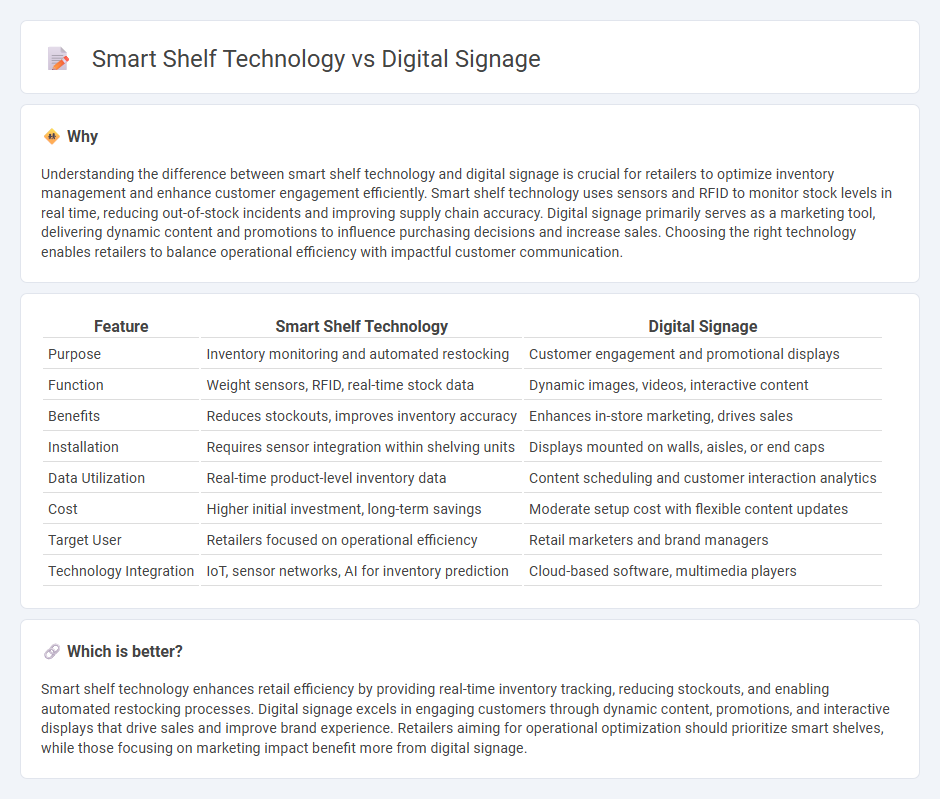
Smart shelf technology enhances inventory management and customer engagement through real-time data and automated restocking alerts, while digital signage focuses on delivering dynamic visual content and promotional messages to shoppers. Both technologies optimize the retail environment by improving operational efficiency and enhancing the shopping experience. Explore more to understand how these innovations transform modern retail strategies.
Why it is important
Understanding the difference between smart shelf technology and digital signage is crucial for retailers to optimize inventory management and enhance customer engagement efficiently. Smart shelf technology uses sensors and RFID to monitor stock levels in real time, reducing out-of-stock incidents and improving supply chain accuracy. Digital signage primarily serves as a marketing tool, delivering dynamic content and promotions to influence purchasing decisions and increase sales. Choosing the right technology enables retailers to balance operational efficiency with impactful customer communication.
Comparison Table
| Feature | Smart Shelf Technology | Digital Signage |
|---|---|---|
| Purpose | Inventory monitoring and automated restocking | Customer engagement and promotional displays |
| Function | Weight sensors, RFID, real-time stock data | Dynamic images, videos, interactive content |
| Benefits | Reduces stockouts, improves inventory accuracy | Enhances in-store marketing, drives sales |
| Installation | Requires sensor integration within shelving units | Displays mounted on walls, aisles, or end caps |
| Data Utilization | Real-time product-level inventory data | Content scheduling and customer interaction analytics |
| Cost | Higher initial investment, long-term savings | Moderate setup cost with flexible content updates |
| Target User | Retailers focused on operational efficiency | Retail marketers and brand managers |
| Technology Integration | IoT, sensor networks, AI for inventory prediction | Cloud-based software, multimedia players |
Which is better?
Smart shelf technology enhances retail efficiency by providing real-time inventory tracking, reducing stockouts, and enabling automated restocking processes. Digital signage excels in engaging customers through dynamic content, promotions, and interactive displays that drive sales and improve brand experience. Retailers aiming for operational optimization should prioritize smart shelves, while those focusing on marketing impact benefit more from digital signage.
Connection
Smart shelf technology integrates sensors and RFID tags to monitor inventory levels in real-time, while digital signage dynamically displays relevant product information and promotions based on shelf data. This connection enables retailers to enhance customer experience by providing accurate stock availability and personalized advertisements at the point of sale. Combining smart shelves with digital signage optimizes inventory management and drives increased sales through targeted marketing.
Key Terms
Visual Merchandising
Digital signage enhances visual merchandising by displaying dynamic, targeted content that captures customer attention and drives engagement. Smart shelf technology uses sensors and real-time data to optimize product placement, monitor inventory, and personalize shopping experiences. Explore how combining these innovations can transform retail environments and boost sales performance.
Real-time Analytics
Digital signage and smart shelf technology both leverage real-time analytics to enhance retail operations, with digital signage focusing on dynamic content changes based on customer behavior and smart shelves providing instant inventory data and shopper interaction insights. Real-time analytics in digital signage enable personalized advertising and improved customer engagement, while smart shelves optimize stock management and reduce out-of-stock situations by tracking product movement precisely. Explore more to understand how integrating these technologies can drive data-driven retail strategies and maximize ROI through real-time insights.
Customer Engagement
Digital signage enhances customer engagement by delivering dynamic, targeted content that captures attention and drives interaction in real-time retail environments. Smart shelf technology uses weight sensors and RFID tags to monitor product availability and customer behavior, offering personalized promotions based on inventory data and shopper preferences. Explore the latest innovations in digital signage and smart shelf technology to transform your retail strategy and maximize customer engagement.
Source and External Links
Digital signage - Wikipedia - Digital signage uses digital display technologies to present multimedia content such as video, images, or interactive media for advertising, information, branding, or entertainment across public and private environments, with networked or standalone systems commonly deployed in various sectors including retail, transportation, and healthcare.
What Is Digital Signage? [+ How It Can Help Your Business] - Digital signage includes various display types like digital directories, electronic message signs, and advertising monitors that improve navigation, enable real-time updates, and enhance customer engagement in locations like malls, hospitals, and corporate buildings.
Amazon Digital Signage Solutions for Business - Amazon offers the Signage Stick, a plug-and-play device designed for easy digital signage setup with secure, scalable performance supporting 4K video and integration with multiple Content Management Software platforms for professional displays.
 dowidth.com
dowidth.com